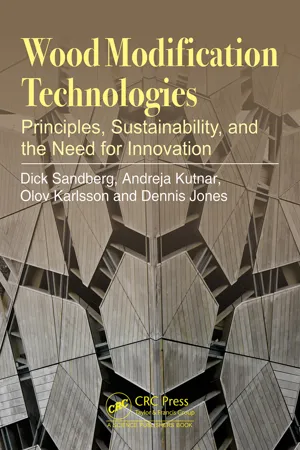
Wood Modification Technologies
Principles, Sustainability, and the Need for Innovation
- 432 pages
- English
- ePUB (mobile friendly)
- Available on iOS & Android
Wood Modification Technologies
Principles, Sustainability, and the Need for Innovation
About This Book
The market for durable products using modified wood has increased substantially during the last few years. This is partly because of the restriction on the use of toxic preservatives due to environmental concerns, and to lower maintenance cost and time. Furthermore, as sustainability becomes a greater concern, the environmental impact of construction and interior materials is factored in planning by considering the whole life cycle and embodied energy of the materials used.
Wood is modified to improve its intrinsic properties, enhance the range of applications of timber, and to acquire the form and functionality desired by engineers without calling the environmental friendliness into question. Wood modification processes are at various stages of development, and the challenges faced in scaling up to industrial applications differ.
The aim of this book is to put together the key elements of the changes of wood constituents and the related changes in wood properties of modified wood. Further, a selection of the principal technologies implemented in wood modification are presented. This work is intended for researchers, professionals of timber construction, as well as students studying the science of materials, civil engineering and architecture. This work is not exhaustive, but intends to deliver an outline of the scientific disciplines necessary to apprehend the technologies of wood modification and its behavior during treatment, as well as during its use.
Frequently asked questions
Information
Chapter 1
Wood and Wood Modification
1.1 Wood modification
- a change in wood properties as a result of changes in silvicultural practices and the ways of using wood,
- awareness of the limited availability of rare species with outstanding properties for modern use, such as durability and appearance,
- awareness and restrictions by law of the use of environmental non-friendly chemicals for increasing the durability and reducing the maintenance of wood products,
- increased interest from the industry to add value to sustainably sourced local sawn timber and by-products from the sawmill and refining processes further along the value chain,
- EU policies supporting the development of a sustainable society, and
- the international concern for climate change and related activities mainly organised within the frame of the United Nations (UN), such as the Paris Agreement under the United Nations Framework Convention on Climate Change (UNFCCC).
What is wood modification?
- treatments aiming to improve wood properties such as fire/flame stability (cf. Lowden and Hull, 2013; Visakh and Arao, 2015),
- preservation of ancient small artefacts (cf. Unger et al., 2001),
- wood particles or disintegrated wo...
Table of contents
- Cover
- Title Page
- Copyright Page
- Preface
- Table of Contents
- 1. Wood and Wood Modification
- 2. Chemical Modification Processes
- 3. Thermally-based Modification Processes
- 4. The Use of Microwaves, Plasma and Laser for Wood Modification
- 5. Other Modification Processes
- 6. Modified Wood Beyond Sustainability
- Appendix
- Index